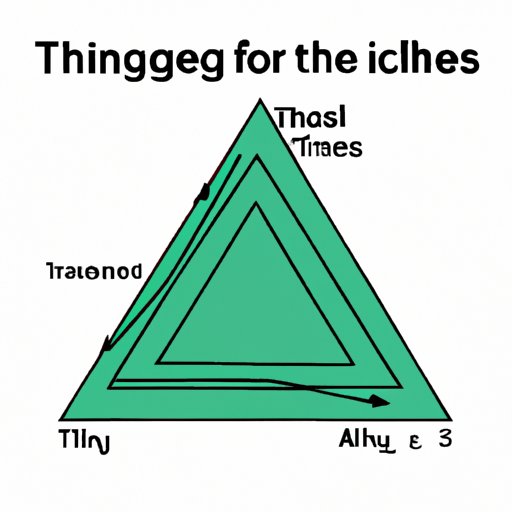
Introduction
Finding the base of a triangle is a vital skill in geometry. It is often used to solve real-world problems in fields such as engineering, physics, architecture, and construction. In this article, we will explore six methods for finding the base of a triangle. Each method is outlined step by step, complete with examples to help you better understand the process. Ultimately, this guide empowers you to solve for the base of any triangle you encounter.
Geometric Method
The Pythagorean Theorem is a well-known formula in geometry that connects the sides of a right triangle. It states that the square of the hypotenuse (the longest side) is equal to the sum of the squares of the other two sides. This theorem can be used to find the base of a right triangle.
To use the Pythagorean Theorem to solve for the base of a right triangle:
- Identify the hypotenuse and the two other sides of the right triangle.
- Write the Pythagorean theorem formula: a^2 + b^2 = c^2.
- Plug in the known values for the hypotenuse and the other side. Let’s say the hypotenuse is 5 and the other side is 3: 3^2 + b^2 = 5^2.
- Solve for b: b^2 = 25 – 9; b^2 = 16. b=4.
For instance, if the hypotenuse is 5 and one side is 3, then the base is 4.
Trigonometric Method
Trigonometry deals with the study of triangles and the relationships between their sides and angles. By using the sine, cosine, and tangent functions, you can calculate the base of a triangle.
To use the trigonometric functions to solve for the base of a triangle:
- Identify the angle and the length of the side adjacent to it.
- Write the sine, cosine, or tangent formula, depending on the known angle.
- Plug in the known values and solve for the missing side.
For example, to find the base of a triangle given the angle and the hypotenuse length:
- Identify the angle and the hypotenuse of the triangle. Let’s say the angle is 60 degrees and the hypotenuse is 10.
- Write the sine formula: sin(60) = b/10.
- Solve for b: b = 8.66.
Therefore, the base of the triangle is approximately 8.66.
Area Method
The area method involves computing the area of the triangle using the formula A = (1/2)bh and solving for b, the base.
To use the area method:
- Identify the height of the triangle and its area.
- Write the area formula: A = (1/2)bh.
- Plug in the known values for the area and the height and solve for b.
For example, if the area of a triangle is 20 and its height is 5:
- Write the area formula: 20 = (1/2)(b)(5).
- Multiply both sides by 2: 40 = (b)(5).
- Divide both sides by 5: 8 = b.
Using Perimeter Method
The perimeter method involves using the formula P = a + b + c to find the base, given the other two sides of the triangle.
To use the perimeter method:
- Identify the lengths of the two sides adjacent to the base.
- Write the perimeter formula: P = a + b + c.
- Plug in the known values for a, c, and P, and solve for b.
For instance, if two sides adjacent to the base are 3 and 4 and the perimeter is 12, we can find the base as follows:
- Write the perimeter formula: 12 = 3 + 4 + b.
- Subtract 7 from both sides: 5 = b.
Therefore, the base of the triangle is 5.
Using Altitude Method
The altitude method involves finding the height of the triangle and using the formula A = (1/2)bh to solve for the base.
To use the altitude method:
- Identify the height of the triangle, given the area.
- Write the area formula: A = (1/2)bh.
- Plug in the known values for the area and the height, and solve for b.
For example, if the area of the triangle is 15 and its height is 6:
- Write the area formula: 15 = (1/2)(b)(6).
- Multiply both sides by 2: 30 = (b)(6).
- Divide both sides by 6: 5 = b.
Therefore, the base of the triangle is 5.
Using Similar Triangles
Similar triangles are those that have the same shape but different sizes. If you have two similar triangles, you can use their proportional sides to find the base of one triangle when given the base of the other.
To use similar triangles:
- Identify two similar triangles, where one triangle has the base length known and the other has the same proportional sides as the first triangle.
- Write the proportion, setting the lengths of the corresponding sides equal to each other.
- Solve for the missing length.
For example, suppose you have two similar triangles, one with base 4 and corresponding side lengths of 6 and 8, and the other with corresponding side lengths of 9 and 12. To find the base of the second triangle:
- Write the proportion: 4/6 = b/9.
- Cross-multiply: 4(9) = 6(b).
- Solve for b: b = 6.
Therefore, the base of the second triangle is 6.
Conclusion
We have covered six methods for finding the base of a triangle: geometric, trigonometric, area, perimeter, altitude, and similar triangles. Each method is outlined step by step, with examples to help improve your understanding of the process. Armed with these tools, you can solve for the base of any triangle you encounter.
To further improve your understanding of these methods, it is recommended to practice solving problems involving triangles of different shapes and sizes. Drawing diagrams can also be helpful in visualizing the problem and identifying the appropriate method to use. With practice and persistence, you will become proficient in finding the base of any triangle.





